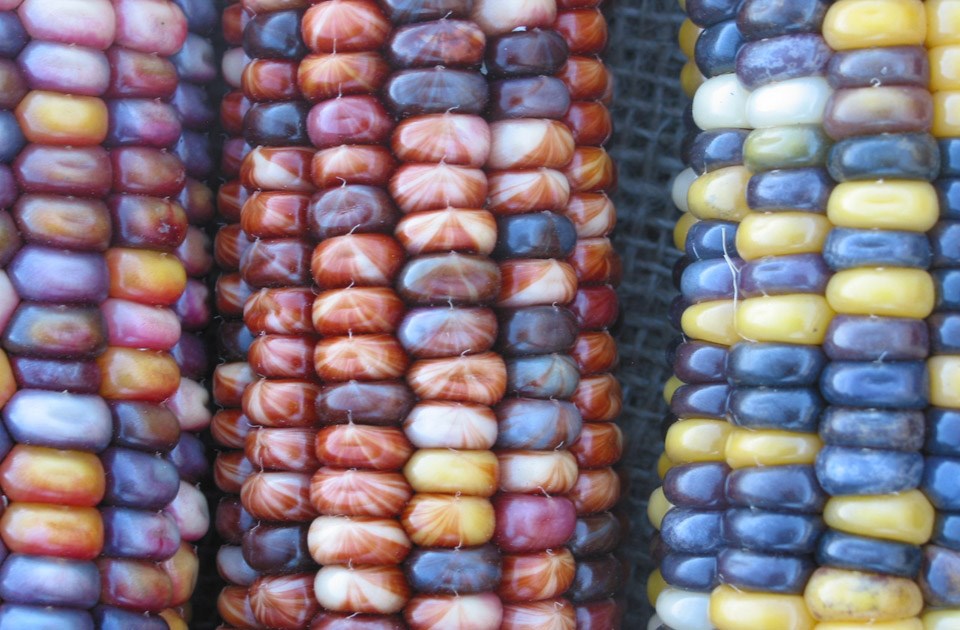Sweet corn (Zea mays) has been a staple in the Prairie garden for decades. Although corn was domesticated by native people in Mexico approximately 10,000 years ago, it is only in the last 30 years that Prairie gardeners have been able to consistently harvest sweet corn from their gardens every year.
The garden corn that was available when I was a kid (some 50+ years ago) was a special treat since our growing season tended to be somewhat shy of producing fully ripe corn. Even though the fresh corn back then was amazing for the time, there is no comparison to the types of sweet corn we can grow in our Prairie gardens today. In the past, the corn that we grew was called a ‘Standard’ type or ‘Normal Sugary (su),’ Any sweetness in these cobs would disappear one day after harvest and the texture of the kernels could be quite mushy. If you didn’t harvest the cobs at just the right time, the quality was not great, but we were happy because we had a rare treat of fresh corn on the cob.
Over the last several decades, corn breeding has come a long way. There are now several types available, and they each have their unique qualities.
When supersweet (sh2) corn cultivars were first introduced several decades ago, it was exciting because not only did the sweetness improve, but that flavour lasted in storage as well as on the plant: one didn’t need to pick corn on exactly the correct day for prime quality. Many of the supersweets had a tougher texture at that time and they also required a bit longer growing season; many were not reliable cultivars for Prairie gardeners.
Sugar-enhanced (se) corn cultivars were also released several decades ago and were touted as being more tender than supersweet cultivars and slightly earlier maturing. Sugar-enhanced cultivars did not have the extreme sweetness of the supersweets, but they had better flavour than the old standard cultivars.
About 20 years ago, synergistic and augmented corn cultivars came on the market. Both types demonstrated improvements in flavour and texture over the sugar-enhanced and supersweet cultivars.
Ornamental corn is not a sweet corn but rather a flint corn. Ornamental corn is often used for decorative purposes, but it can be used for cooking: hominy, grits, corn meal or masa.
Corn breeding over the last 20 years has also resulted in a huge number of excellent corn cultivars available to Prairie gardeners. Combining the new genetics with a longer and hotter growing season than in the past has secured a sweet corn harvest in nearly every Prairie garden every summer. When selecting corn cultivars to grow, choose cultivars that mature in 75 days or less.
Corn is a warm-season crop and should be seeded when the soil has warmed up in spring to at least 15 C (third or fourth week in May). Early planting into cold soil may result in seed rot.
Corn does not like to have its roots disturbed; avoid transplanting. Sweet corn plants love heat, moisture and fertile soil. If corn leaves look chlorotic (yellow) during the growing season, add some extra compost to the soil or apply some 20-20-20 soluble fertilizer. Mix fertilizer according to label directions. Apply at least 2.5 centimetres of water weekly when the corn is actively growing.
Corn is cross-pollinating. Corn plants produce the male pollen in tassels at the top of the plant. The silks in the cob are each connected to one kernel in the cob. The pollen must travel down the silk to each kernel for the kernels to develop. Missing kernels in a cob indicate that there was poor pollination. Plant garden corn in a square block, rather than one long row, to ensure successful pollination. If you are growing more than one type of sweet corn or a sweet corn cultivar and an ornamental corn cultivar, separate the two different types by at least six to eight metres. Cross-pollination between two different types of corn will negatively affect cob quality.
Corn has few insect issues; however, with the increase in the amount of field corn being grown for livestock, corn earworm has become an issue. Corn earworm is not a worm but rather a caterpillar. Moths flying in from the United States lay their eggs on the new leaves and silks in August. The eggs hatch out in a few days and the ‘worms’ burrow into the tip of the cob. Usually, not more than one-third of the cob is affected. There is no effective spray for this pest. Simply cut off the chewed part of the cob, and the remainder of the cob is completely edible.
How do you know when your corn cob is ready for harvest? The silks on the cob should have dried up and the tip of the cob should feel blunt to the touch, rather than tapered. If you are still not sure, peel back a bit of the husk on the tip to see if the kernels look plump and ready. Remember that sweet corn now comes in yellow, bicolour and even white kernels, so check for mature kernel colour as well.
Good luck with your corn this season. Get out the butter and salt.
This column is provided courtesy of the Saskatchewan Perennial Society.
(SPS; [email protected]). Check our website (www.saskperennial.ca) or Facebook page (www.facebook.com/saskperennial) for a list of upcoming gardening events.




